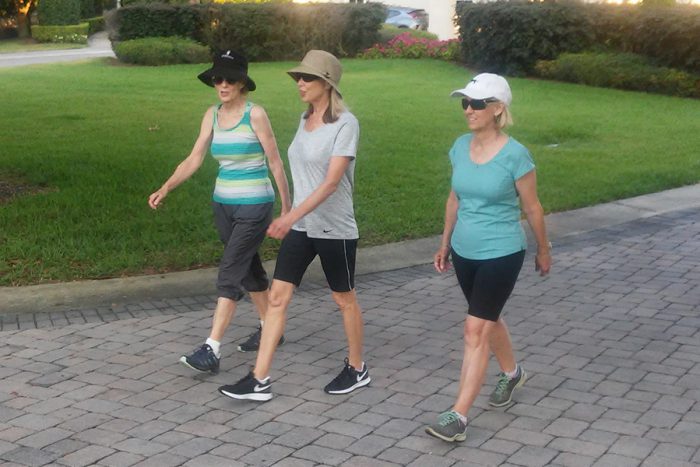Walking for Exercise
Walking Workout

Female members of Golden Ocala Golf & Equestrian Club recently instituted a morning walk club, which sparked a question about the benefits of walking for exercise. If you take a lesson from Fitness Director Jeff S
paeth, you’ll find that there are obvious advantages and ways to capitalize on those advantages. Of course, as with anything, there are limits, as well as telltale signs that let you know when to push and back off those limits.
Benefits of Walking for Exercise
The biggest benefits of walking for exercise are healthy weight, lower high blood pressure, strong bones and muscles, and better balance.
But that begs a question — how? Jeff finds that even just basic walking makes your heart stronger — pumping more blood with less effort and placing less force on your arteries, thereby lowering high blood pressure. Meanwhile, bones and muscles become stronger when muscles pull and tug against bones during physical activity, and since walking is a weight-bearing exercise, it requires you to use your body weight as a ballast. Then, as you build lower body strength, your body maintains balance through proprioceptors — or sensory receptors that respond to position and movement.
Capitalizing on the Benefits of Walking
To achieve all that Jeff deems possible, you should walk fast enough to achieve a fat-burning pace. This means walking at least 45 minutes in your specific fat-burning rage, which varies by age. If you’re confused, just subtract your age from 220 before taking 50 to 80% of that number as your targeted fat-burning heartrate.
You should also try brisk walking for 18 to 20 minutes, as this will increase endurance and reduce anxiety by releasing endorphins like adrenalin, serotonin and dopamine.
And while you’re at it, holding hand weights or wearing a weighted backpack — if your fitness level is above normal — is a good idea. Fitness levels vary from person to person and depend on muscle tissue, genetic makeup, BMI and overall health. The normal resting heartrate for healthy adults ranges from 60 to 100 beats per minute, while their BMI is between 18.5 to 24.9. To calculate yours, simply divide your weight by your height and multiple it by 703.
To complement walking as an exercise, give strength training, yoga, Pilates and swimming a try. This will fill in the gaps that walking creates — just ask the world’s top athletes.
Pre-Workout Stretches and Warmups

Before you begin walking, you must stretch and warmup. Start with ankle circles, leg springs, pelvic loops and arm circles — 30 seconds each. Then, transition to ball stretches, calf stretches and standing groin stretches. This will especially improve flexibility among people who are aging.
Ball stretches include lifting a ball over your head while lying on a flat surface. Raise the ball above your head before lowering it behind your head. Calf stretches are performed by elevating the front of your foot on a raised surface and pointing heals down. For the standing groin stretch, stand on one leg and lunge forward with your torso in an upright position. Then, lower your knee until it nearly touches the groin. Regardless of the stretch, hold it for 30 seconds.
Limits of Walking for Exercise
In Jeff’s experience, there are several limits to walking for exercise — a lack of energy-enabling fuel, injuries, inclement weather and pushing too hard too fast.
ATP (Adenosine Triphosphate) is a chemical stored in the muscle that produces energy and increases energy levels based on how much O2 enters the body. In other words, the advantages to walking are only as abundant as the energy you have to complete the exercise. And no matter how much energy you may have, if you have a leg, knee or ankle injury, you cannot walk — period!
Inclement weather can also put a damper on your walk. For example, an approaching thunderstorm increases your risk of getting struck by lightning, while dense fog makes it difficult for approaching vehicles to spot you.
Even if it’s a sunny day and you have no injuries to speak of and your energy level is at its peak, you’re still vulnerable to pushing yourself too hard too fast. For example, you may finish your determined route, but feel exhausted or faint, as your heart races and you begin to experience cold sweats and obtain pale skin. If that’s not the case, but you toss and turn in your sleep, your sympathetic nervous system is likely still active. Another sign may be one illness after another and/or consistently sore muscles.
Overcoming the Limits of Walking 
Just as every cloud has a silver lining, so does Jeff have numerous ways to overcome the limits of walking. Start with comfortable walking shoes that are form fitting and contain soft insoles. With these shoes, walk up and down elevated paths or walkways, rather than a flat surface, to get more positive walking results. And make sure that this path or walkway is safe, well-lit and surrounds an area that you recognize.
Other hazards to consider are wearing too many clothes that might cause overheating, walking with uneven strides and in a slouched position (looking down, not holding your stomach in and not bending your elbows at a 90° angle), and walking too slow. While a fit individual will not be impacted by a slow walk, others will struggle to obtain an elevated heartrate via a steady, fast heartbeat. At the end of the day, a slow walk only benefits those who are out of shape or in a rehab program.
Lastly, you can most definitely avoid injuries by maintaining firm footing — allowing you to walk for as long as you desire!
Jeff Spaeth and his fitness team can, without a doubt, prepare you for walking for exercise — and all that is associated with it. For more information, call the Fitness Center at (352) 402-4350.